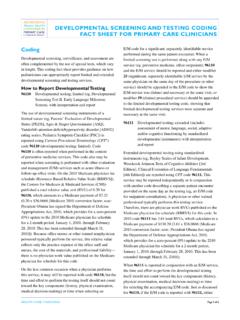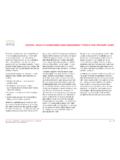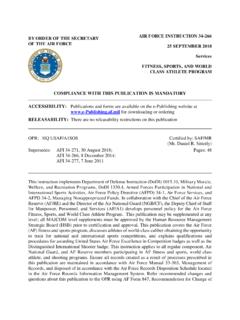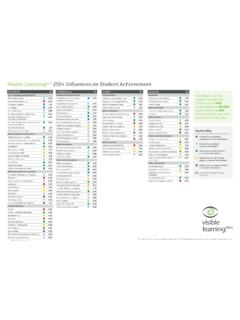Transcription of inattention and impulsivity - HEARD Alliance
1 Decision support for cliniciansinattention and impulsivitypage 1 of 7 Children may suffer from inattention and impulsivity for a variety of reasons and to various degrees. Attention-deficit/hyperactivity disorder (ADHD) occurs in about 8% of children and youth,1 who experience significant impairment in their functioning as a result of their symptoms. As part of their disability, individuals with ADHD frequently have deficits in social skills, impairing their abilities to function well in school and social ADHD can result in significant consequences. Follow-up studies have found that children with ADHD, particularly those untreated, are at greater risk for school failure, underemployment, difficulty with legal authorities, substance abuse, and the consequences of risky behaviors including motor vehicle crashes and sexually transmitted Because of the prevalence and clinical significance of ADHD and the effectiveness of primary care interventions.
2 The American Academy of Pediatrics recommends that pediatric primary care clinicians achieve competence in the care of children and adolescents with Results suggesting inattention and impulsivityPediatric Symptom Checklist (PSC)-35: Total score 24 for children 5 years and younger; 28 for those 6 to 16 years; and 30 for those 17 years and older AND further discussion of items related to attention and impulse control confirms a concern in that area. PSC-17: Attention subscale is 7 AND further discussion of items related to attention and impulse control confirms a concern in that area.
3 Strengths and Difficulties Questionnaire (SDQ): Total symptom score of >19; hyperactivity scale score of 7 to 10 (see instructions at ); impact scale (back of form) score 2 indicates some degree of impairment; AND further discussion of items related to attention and impulse control confirms a concern in that and Clinical Findings suggesting inattention and impulsivityParental concerns or history suggest Excitability, impatience, angry outbursts (greater than peers) Wandering attention (greater than peers) Difficulties with behavior at home and in the classroom Academic difficulties Parents and teachers presuming diagnosis of ADHD or seeking diagnosis of ADHDC onditions that may mimic or Co-occur With inattention and impulsivity Differentiate From Normal BehaviorAll children may be inattentive or impulsive at times, but for some children, inattention and impulsivity limit their adaptability to normal peer and family situations and interfere with learning.
4 inattention and impulsivity are typical characteristics of preschool children, but extremes of these behaviors warrant further evaluation (eg, getting expelled from child care because of behavior). Boisterousness or dreaminess can be normal behavior patterns in older children. Children with limited social experiences and those whose environment is relatively less structured may appear impulsive and inattentive compared with their peers, especially when entering highly structured situations such as a classroom or organized group or vision problems. All children who appear inattentive should be screened for sensory deprivation.
5 Sleep problems can cause inattention and irritability. ADHD may contribute to difficulty sleeping. Please note: This guidance is based on the work of the World Health Organization ( ) and may be updated annually. Check Feedback & Updates 2 of 7 ADHD. Diagnosis requires that child have 6 of 9 features of inattention careless with detail; fails to sustain attention; appears not to listen; does not finish instructed tasks; poor self-organization; avoids tasks requiring sustained mental effort; loses things; easily distracted; and seems forgetful. Diagnosis also requires that child have 6 of 9 features of hyperactivity or impulsivity fidgets; leaves seat when should be seated; runs or climbs excessively and inappropriately; noisy in play; persistent motor activity unmodified by social context (but this is seen less in teens); blurts out answers before question completed; fails to wait turn; interrupts others conversation or games; and talks excessively.
6 Further features necessary to make this diagnosis include These things happen in at least 2 types of situation (eg, home and school). The problems are recognized by or before age 7 years. The problem causes significant distress or impaired functioning. The problem is not better explained by another psychiatric problems or disabilities. If symptoms of inattention and impulsivity are associated with problems of school performance, the child may be experiencing learning difficulties. See Learning Difficulties guidance to explore this possibility. Developmental problems. Children with overall intellectual or social limitations may appear less able to control their impulses and to focus and maintain their attention than their impairment or disorder.
7 Children with language impairment may be frustrated and inattentive. Depression. May co-occur with ADHD. Marked sleep disturbance, disturbed appetite, low mood, or tearfulness could indicate that a child is depressed as well as having attention difficulties. See Depression to adverse childhood experiences (ACE). Children who have experienced or witnessed trauma, violence, a natural disaster, separation from a parent, parental divorce or separation, parental substance use, neglect, or physical, emotional, or sexual abuse are at high risk of developing inattention and impulsivityemotional difficulties such as adjustment disorder or post-traumatic stress disorder (PTSD).
8 Some symptoms of PTSD may resemble symptoms of ADHD, eg, hypervigilance may mimic hyperactivity, or dissociation may mimic inattention . These children may also manifest other forms of anxiety. Inquiring about previous trauma in a confidential setting is important. See Anxiety Anxious children may experience difficulty concentrating. See Anxiety guidance. Bereavement. The vast majority of children will experience the death of a family member or friend sometime in their childhood. Other losses may also trigger grief responses separation or divorce of parents, relocation, change of school, deployment of a parent in military service, breakup with a girlfriend or boyfriend, or remarriage of parent.
9 Such losses are traumatic. They may result in such symptoms as sadness, anxiety, difficulty concentrating, poor impulse control, or academic decline immediately following the loss and, in some instances, more persistently. See also Depression guidance and the discussion of PTSD in Anxiety guidance. Physical illness. Medical issues that can mimic or provoke symptoms of inattention and impulsivity include thyroid disease, hypoglycemia, hyperglycemia, side effects of medications (eg, bronchodilators), and endocrine tumors (eg, rarely pheochromocytoma). Substance use. Children with symptoms of inattention and impulsivity may self-medicate with alcohol, nicotine, or other drugs.
10 Conversely, children using substances may manifest inattention , impulsivity , and deteriorating school or oppositional disorders. See Disruptive Behavior and Aggression guidance to differentiate these symptoms from problems of inattention and impulsivity and syndrome. Children with repetitive movements (tics) should be identified. In children with Tourette syndrome, ADHD symptoms may precede onset of tics. Stimulant medication may worsen tics. It is important to tailor treatment to the child s most pressing symptoms before deciding the risks and benefits of using stimulants in children with both support for clinicianspage 3 of 7inattention and impulsivityDecision support for clinicianstools for Further assessment of inattention and impulsivityVanderbilt ADHD Rating Scale (teacher and parent scales): This tool is appropriate for children 6 to 12 years of age.










